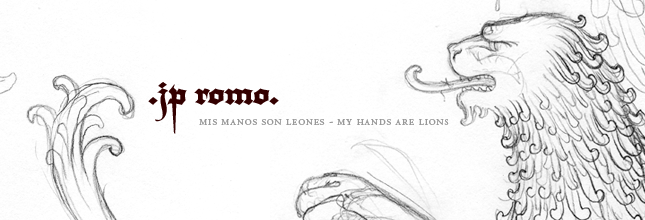 This devil was the first left-handed drawing I made after hurting my right wrist. He would probably be upset to know he looks like a unicorn. I guess that's just part of the beauty of drawings made with the naïve hand, that they don't look quite... right. I think the texture is cool, though. But nevermind that.
This devil was the first left-handed drawing I made after hurting my right wrist. He would probably be upset to know he looks like a unicorn. I guess that's just part of the beauty of drawings made with the naïve hand, that they don't look quite... right. I think the texture is cool, though. But nevermind that. I was thinking about the devil at that moment because... well, it simply came to my mind. But the reason for that was probably that the left hand has been associated with the devil in many ways throughout history... the right hand is righteous, the left hand is sinister. Left-handedness was seen as evil for a long time in many cultures.
Unfortunately, this hasn't changed enough. Even if now lefties aren't discriminated against by society like other minorities, many still suffer from some of the consequences of being different. Teachers still often see left-handed kids as an annoyance (asking for special scissors when they don't really need them, writing all dirty, requesting to sit at particular places...) and sometimes even encourage them (I would hope no sane teacher would force them) to learn to write with their right hand because it's easier (to learn or to teach, I wonder...). That's the same situation of encouraged denial of one's identity that too many people face everyday: a lefty kid who has to choose between an unnatural and uncomfortable switch of hands and a piggy face on his notebook; a deaf kid who has to choose between getting taught in a language he can barely understand and not getting taught at all; a gay Christian who has to choose between living a lonely life and leaving his church, or even his family. I know it's not always possible to eliminate these painful dilemmas... but it still sucks to be between the devil and the deep blue sea. I'll repeat something I posted a couple of months ago: No one should ever have to choose between two parts of their identity.
OK, so I managed to turn this into a protest, haha. How's that for Left (Mexican political Left anyway)? I shouldn't be complaining so much, complaining is always annoying and it is most certainly not the objective of this blog; but these last days (maybe even weeks or months) I've been especially bothered by the weight of my individuality and its implications. Nothing regarding my left-handedness, which is completely fake and temporary, but rather some other much more real, natural and permanent aspects of myself that make me very different from the majority. But oh well... again, nevermind that. Enjoy the drawing and its cool texture, which I couldn't have achieved with my right hand.
Este diablo fue el primer dibujo «zurdo» que hice después de lastimarme la muñeca derecha. Probablemente le daría vergüenza saber que parece un unicornio... pero eso es parte de la belleza de los dibujos hechos con la mano ingenua: la destreza le cede el paso a la sinceridad. O algo así...
Estaba pensando en el diablo en esos momentos porque... (pos quién sabe, se mi'ocurrió nomás...)... probablemente porque la mano izquierda ha sido asociada con el diablo de muchas formas a través de la historia. La mano derecha es diestra y la otra es siniestra. Durante mucho tiempo y en muchas culturas, la zurdera se vio como una abominación o, en el mejor de los casos, un defecto a corregir.
Por desgracia, esto no ha cambiado lo suficiente. Los zurdos ya no son discriminados por la sociedad como otras minorías, pero muchos todavía sufren las consecuencias de ser diferentes. Aún hoy muchos maestros ven a los niños zurdos como una molestia (pues sí: hay que mover las bancas, no saben usar las tijeras, escriben sucio...), e incluso los animan (seamos optimistas y pensemos que no los obligan) a aprender a escribir con la mano derecha porque «es más fácil» (...¿aprenderlo o enseñarlo?). Y a esa misma situación, que fomenta la negación de la identidad, se enfrentan muchísimas personas todos los días: un niño zurdo que tiene que escoger entre «volverse diestro» y retorcerse en la banca; un niño sordo que tiene que escoger entre recibir educación en un idioma que apenas entiende y no recibir educación; un cristiano homosexual que tiene que escoger entre vivir una vida solitaria y dejar su iglesia o incluso a su familia. Yo sé que algunas de estas encrucijadas son inevitables, pero de cualquier forma es una joda estar entre la espada y la pared. Repito una frase (ajena) que publiqué hace un par de meses: Nadie debería jamás verse obligado a elegir entre dos partes de su identidad.
¿Qué tal? Convertí esto en una protesta. Será que lo escribió mi mano Izquierda. No debería quejarme tanto, es molesto y definitivamente no es el objetivo de este blog; pero estos últimos días (o semanas o meses) me ha pesado mucho mi individualidad y sus implicaciones. No pesa mi zurdera, que es completamente falsa y temporal, sino otros aspectos de mí, mucho más reales, naturales y permanentes, que me hacen muy diferente de la mayoría. Pero eso qué importa. Disfrutad el dibujo y su chidísima textura, que difícilmente habría salido de mi mano derecha.








